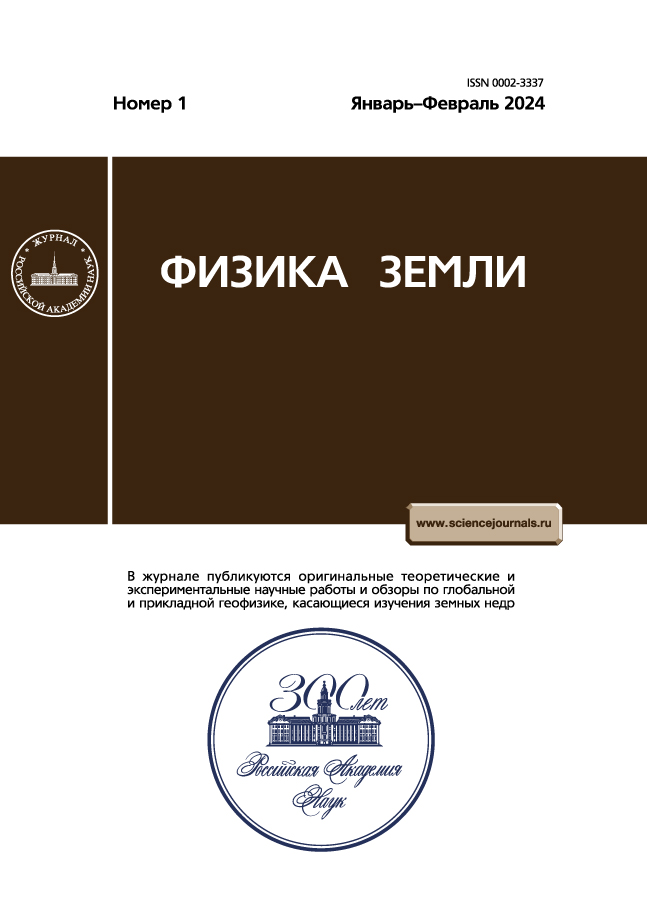Synchrony between dipole and quadrupole during magnetic field reversals and excursions
- Authors: Reshetnyak M.Y.1,2
-
Affiliations:
- Schmidt Institute of Physics of the Earth, Russian Academy of Sciences
- Pushkov Institute of Terrestrial Magnetism, Ionosphere and Radio Wave Propagation, Russian Academy of Sciences
- Issue: No 1 (2024)
- Pages: 3-10
- Section: Articles
- URL: https://journals.eco-vector.com/0002-3337/article/view/658196
- DOI: https://doi.org/10.31857/S0002333724010016
- EDN: https://elibrary.ru/EOCWHD
- ID: 658196
Cite item
Abstract
In contrast to reversals, excursions of the geomagnetic field can occur at lower convection intensities in the Earth’s core. Since in such geodynamo regimes the behavior of the magnetic field is still quasi regular, a reduction of the dipole field during an excursion may indicate a global failure of the dynamo process. As a consequence, it is possible that during the excursion, not only the dipole component, but also the higher harmonics of the field decrease. This hypothesis is tested in a three-dimensional (3D) dynamo model.
Keywords
Full Text
About the authors
M. Yu. Reshetnyak
Schmidt Institute of Physics of the Earth, Russian Academy of Sciences; Pushkov Institute of Terrestrial Magnetism, Ionosphere and Radio Wave Propagation, Russian Academy of Sciences
Author for correspondence.
Email: m.reshetnyak@gmail.com
Russian Federation, Moscow; Moscow
References
- Решетняк М.Ю. Инверсии геомагнитного поля: ограничение на интенсивность конвекции в ядре Земли? // Геомагнетизм и Аэрономия. 2021. Т. 61. № 2. C. 267–272.
- Решетняк М.Ю. Адаптация модели среднего поля в геодинамо // Физика Земли. 2017. № 4. C. 93–99.
- Краузе Ф., Рэдлер К.-Х. Магнитная гидродинамика средних полей и теория динамо. М.: Мир. 1984.
- Christensen U.R., Tilgner A. Power requirement of the geodynamo from ohmic losses in numerical and laboratory dynamos // Nature. 2004. V. 429. № 6988. P. 169.
- Christensen U., Aubert J. Scaling properties of convection-driven dynamos in rotating spherical shells and application to planetary magnetic fields // Geophys. J. Int. 2006. V. 166. P. 97–114.
- Hollerbach R., Jones C.A. Influence of the Earth’s inner core on reversals // Nature. 1993. V. 365. P. 541–546.
- Glatzmaier G.A. Introduction to modeling convection in planets and stars: Magnetic field, density stratification, rotation. Princeton University Press. 2013.
- Gubbins D. The distinction between geomagnetic excursions and reversals // Geophys. J. Int. 1999. V. 137. № 1. P. F1–F3.
- Hulot G., Mouël J.Le. A statistical approach to the earth’s main magnetic field // Phys. Earth Planet. Int. 1994. V. 82. № 3-4. P. 167–183.
- Ogg J. Geomagnetic polarity time scale. Elsevier. 2020.
- Valet J.-P. Time variations in geomagnetic intensity // Rev. Geophys. 2003. V. 41. № 1. P. 4.
- Wicht J. Inner-core conductivity in numerical dynamo simulations // Phys. Earth Planet. Int. 2002. V. 132. № 4. P. 281–302.
- Zhang K., Gubbins D. Is the geodynamo process intrinsically unstable? // Geophys. J. Int. 2000. V. 140. № 1. P. F1–F4.
Supplementary files












